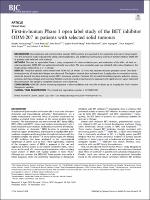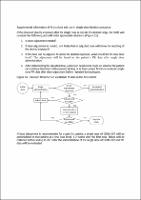| dc.contributor | Vall d'Hebron Barcelona Hospital Campus |
| dc.contributor.author | Ameratunga, Malaka |
| dc.contributor.author | Braña Garcia, Irene |
| dc.contributor.author | Bono, Petri |
| dc.contributor.author | Postel-Vinay, Sophie |
| dc.contributor.author | Plummer, Ruth |
| dc.contributor.author | Aspegren, John |
| dc.date.accessioned | 2021-10-29T11:56:31Z |
| dc.date.available | 2021-10-29T11:56:31Z |
| dc.date.issued | 2020-12-08 |
| dc.identifier.citation | Ameratunga M, Braña I, Bono P, Postel-Vinay S, Plummer R, Aspegren J, et al. First-in-human Phase 1 open label study of the BET inhibitor ODM-207 in patients with selected solid tumours. Br J Cancer. 2020 Dec 8;123(12):1730–6. |
| dc.identifier.issn | 1532-1827 |
| dc.identifier.uri | https://hdl.handle.net/11351/6488 |
| dc.description | Desenvolupament de fàrmacs; Melanoma |
| dc.description.sponsorship | The study was sponsored by Orion Corporation, Orion Pharma, Espoo, Finland, the developer of ODM-207. |
| dc.language.iso | eng |
| dc.publisher | Springer Nature |
| dc.relation.ispartofseries | British Journal of Cancer;123(12) |
| dc.rights | Attribution 4.0 International |
| dc.rights.uri | http://creativecommons.org/licenses/by/4.0/ |
| dc.source | Scientia |
| dc.subject | Càncer - Quimioteràpia |
| dc.subject | Medicaments antineoplàstics |
| dc.subject.mesh | Neoplasms |
| dc.subject.mesh | /drug therapy |
| dc.subject.mesh | Antineoplastic Agents |
| dc.title | First-in-human Phase 1 open label study of the BET inhibitor ODM-207 in patients with selected solid tumours |
| dc.type | info:eu-repo/semantics/article |
| dc.identifier.doi | 10.1038/s41416-020-01077-z |
| dc.subject.decs | neoplasias |
| dc.subject.decs | /farmacoterapia |
| dc.subject.decs | antineoplásicos |
| dc.relation.publishversion | https://doi.org/10.1038/s41416-020-01077-z |
| dc.type.version | info:eu-repo/semantics/publishedVersion |
| dc.audience | Professionals |
| dc.contributor.organismes | Institut Català de la Salut |
| dc.contributor.authoraffiliation | [Ameratunga M] The Institute of Cancer Research and Royal Marsden, London, UK. Monash University, Melbourne, Australia. [Braña I] Vall d’Hebron Institut of Oncology (VHIO), Barcelona, Spain. [Bono P] Helsinki University Hospital Comprehensive Cancer Center, Helsinki, Finland. University of Helsinki, Helsinki, Finland. Terveystalo Finland and University of Helsinki, Helsinki, Finland. [Postel-Vinay S] Drug Development Department, DITEP, Gustave Roussy, Villejuif, France. [Plummer R] Translational and Clinical Research Institute, Newcastle University and Newcastle Hospitals NHS Foundation Trust, Newcastle upon Tyne, UK. [Aspegren J] Orion Corporation Orion Pharma, Espoo, Finland |
| dc.identifier.pmid | 32989226 |
| dc.identifier.wos | 000573406600001 |
| dc.rights.accessrights | info:eu-repo/semantics/openAccess |


